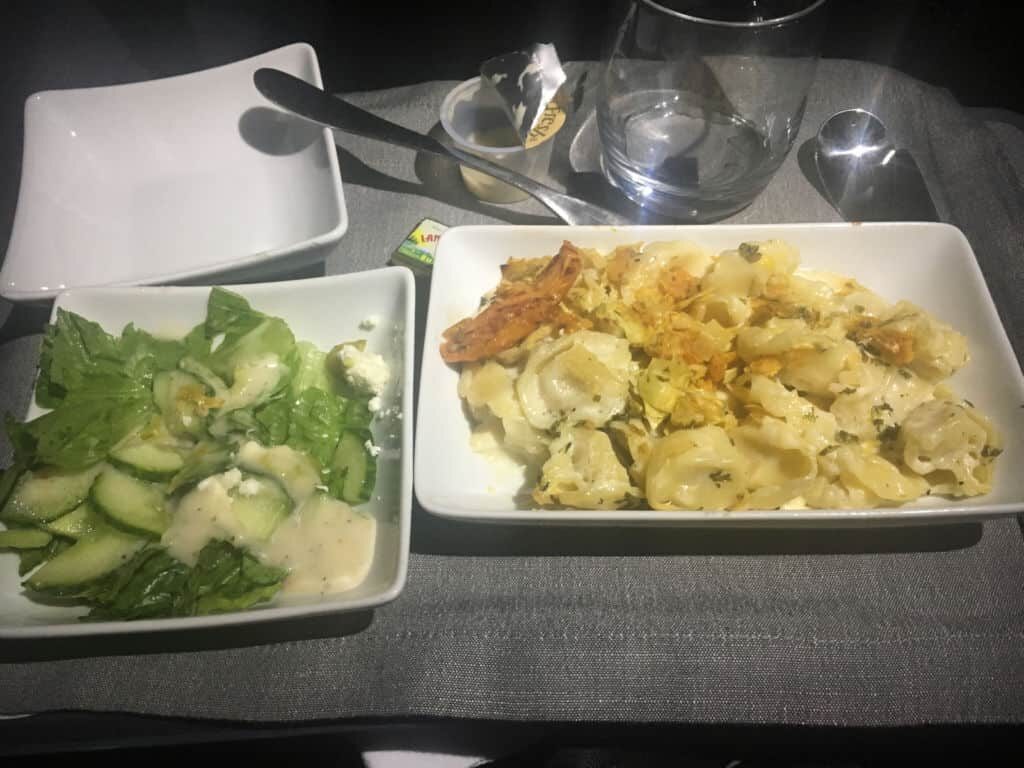 Today's blog post is about airplane food. It's not about the quality of airplane food… it's not an SNL Seinfeld-ish “what's the deal with airplane food?” rant, if you remember that classic sketch.
Today's blog post is about airplane food. It's not about the quality of airplane food… it's not an SNL Seinfeld-ish “what's the deal with airplane food?” rant, if you remember that classic sketch.
As I've sometimes blogged about, I fly American Airlines quite often and I've gained Executive Platinum frequent flyer status. I'm grateful that the status means I get upgraded about 90% of the time.
I'm always fascinated by the variation in service provided by flight attendants in first class.
Sometimes, they offer water and beverages before take off… sometimes, they don't.
Sometimes, they say hello and address you by name after takeoff… sometimes, they don't.
Sometimes, they thank you for being a top-level frequent flyer… sometimes, they don't.
It always makes me wonder what practices are suggested, optional, or an informal standard.
When a meal is served on a flight, there's a usual protocol and procedure… what might be considered “standardized work” in the context of Lean.
If you haven't pre-ordered your meal, the flight attendant might say:
“Mr. Graban, will be you having lunch with us today? We have an option of chicken with couscous or cheese pasta. Which would you like?”
Different flight attendants might use different words, but that's OK since “standardized work” doesn't mean they always use the exact same words… the flight attendants aren't robots, of course.
On a recent flight, the process followed by the flight attendant struck me as being different… very different than the norm.
I wondered, “Are they empowered to practice Kaizen if they've found a better way to do things… or are they violating standardized work?”
The flight attendant had a print out of the flight's meals that included a description and photos. It looked like something just printed on a normal color inkjet printer. It wasn't a professionally printed menu like they'd have on an international flight. It was regular paper. Hmmm.
He sort of shoved that paper toward the passenger in the aisle seat and the passenger grabbed it.
“#1 or #2?” barked the flight attendant somewhat tersely.
“Do you want bread?” he said, as he pointed at pictures of the bread options (a multi-grain roll, a sourdough bread, or something else… I'm not really into bread).
Normally, the flight attendant comes by with a basket of bread and gives you a choice.
This flight attendant's approach was different. I'm not sure if it was better or worse… it was different. That was sort of jarring.
The passenger handed the paper back to the flight attendant who then shoved it toward me.
“#1 or #2?”
I had been on a very similar flight a few days earlier and the food options were exactly the same as that other flight.
“I'll have the chicken please… no bread, thank you.”
I guess I should have said “#1.”
It made me wonder why this flight attendant was taking dinner orders this way when I've NEVER seen another flight attendant do this.
On this route to San Francisco, are there more passengers where language might be a barrier?
Did the flight attendant find this method more efficient, since he didn't need to talk as much?
If the flight attendant thought this method was better, is there a mechanism for him to ask American Airlines headquarters for permission, or is he just empowered to work his own way?
Is there a mechanism for him to suggest his method as a new (better?) standard? Or, again, do flight attendants feel empowered to develop their own process?
I'm sure the answers to these questions would be different if it were a safety issue under the jurisdiction of the FAA.
I wonder if American Airlines knows the flight attendant is working this way? How do they supervise the flight attendants? If a senior flight attendant were on board to observe, would the flight attendant still work this way or would they do things by the book?
Does American Airlines value employee autonomy or would the airline say a consistent experience is more important?
There are no easy answers, eh?
Hearkening back to the Seinfeld SNL sketch, “Who are the ad wizards who came up with this one?”
Of course, Anthony Bourdain thinks I'm crazy for eating airplane food. You can see why… here's the cheese pasta I tried to eat a few days later, when they were already out of the chicken. I mean, here is #2:

Update: I've also posted a version of this story on the FlyerTalk website to see what the response is from other travelers. So far the responses are along the lines of “is this a problem?” and that the flight attendant is being “innovative.”
Please scroll down (or click) to post a comment. Connect with me on LinkedIn.
Let’s build a culture of continuous improvement and psychological safety—together. If you're a leader aiming for lasting change (not just more projects), I help organizations:
- Engage people at all levels in sustainable improvement
- Shift from fear of mistakes to learning from them
- Apply Lean thinking in practical, people-centered ways
Interested in coaching or a keynote talk? Let’s talk.
Join me for a Lean Healthcare Accelerator Trip to Japan! Learn More










I would guess this isn’t kaizen or if it was the attendant was not coached in how to ensure improvements make things better for the customer. It might have saved the attendant time which might have freed him up to take care of passengers better or maybe the food is somewhat hotter because ordering process is quicker (doubtful since usually heated up after selection).
I think it was to make their day easier but possibly done in a way that jeopardizes customer satisfaction with the experience.
One objective in great continuous improvement cultures is the idea of “make your job easier.”
Maybe the flight attendant has made his work easier.
There’s a reason that the Kaizen model at Franciscan usually involves some discussion with a supervisor, either before testing an idea or after. Sometimes a manager might need to push back or challenge an idea that’s good for the employee but maybe not good for the customer.
Or, if the Kaizen idea violates some policy or standard, they need to work together to change the standard.
It’s a balancing act, right? We don’t want people to be afraid to try things, but Kaizen also isn’t an approach where everybody gets to do whatever they want…
That’s why I thought this was worth blogging about… where is this balance found in different situations?
From flyertalk:
“Seems like it might have been photos printed out from AA’s internal catering webpage, which has menus for each group of routes and preparation directions for each of the dishes, along with a photo of what it should look like. Those used to be available publicly, but AA slapped a password on them.”
Hi Mark,
I have similar experiences with Delta, but never have had the visual menu. Other than the attitude that seems to have gone with it, I’d say it’s a pretty good idea. I hear passengers ask endless questions sometimes about the food offered. I guess that attendant thought of a better way to present the options in order to avoid the questions. I have noticed that Delta attendants are pretty much using the standard playbook, though–always use my name, always greet me, if they don’t serve pre-flight drinks it’s always because the plane was late getting in and we are trying for a “quick turnaround.”
It would have been better if the flight attendant said, “Good afternoon, Mr. Graban. This sheet shows your meal choices this evening, which would you like to have?” or something more friendly than “#1 or #2?”
Getting a water or anything before takeoff on American is the exception, rather than the norm…
Comment from LinkedIn:
This makes me wonder. If it was Kaizen, was the Attendant properly trained in the delivery of the new method. Was there an opportunity for customer feedback on the experience? Was the process more efficient? Did the Attendant go rogue or have a bad day; evidenced by his lack of engagement with the passenger? Things that make you go hmmmm…
Good question… if it was an experiment or an attempt at improvement, nobody asked me for input.
Maybe he was having a bad day or not feeling well.
The ordering took less time, but it was a 4-hour flight, so there was no reason to rush, in my mind.
Great article and thoughtful questions!
From my flight attendant and airline catering background, I can confirm that each flight is unique, and passengers’ expectations are so diverse that standardization can be tricky. The only things steady in airline industries are the safety and security processes. Absolutely no room for mistakes or unjustified improvement initiatives in these two areas! Everything else can change anytime. For example, even the destination can vary after takeoff due to weather constraints. When it comes to foodservice, the menu onboard should be highly standardized for a cycle: Weight, color, smell, or texture. However, the flight attendant’s mood, experience, and creativity or the flight circumstances will always impact the service. In general, the flight attendant has permission to improve and adjust the service level according to the passenger. The truth is some passenger expects way more than others. The crew’s ultimate goal is to ensure customer satisfaction as long as safety and security remain the priorities.
Comments are closed.